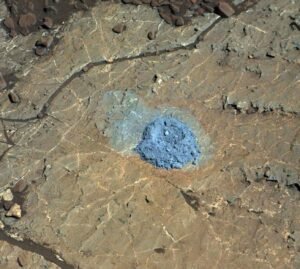Latest Posts
Sol 1984: In search of softer pastures
The rocks in Vera Rubin are really very hard!After the second attempt Curiosity’s driller was not able to dig enough to collect enough material for analysis in this area.Meanwhile engineers continue to try to refine the technique, perhaps adding percussive movements….. This post has been automatically translated. See the original post here.
All about the InSight probe launch
The launch window is scheduled for the early morning hours between May 5 and June 8, from the Vandenberg base in California.During these two weeks, the launch will be able to occur within a two-hour window starting at 4:00 a.m. and will shift 5 minutes with each passing day.Regardless of the exact day of departure, the arrival on Mars is scheduled for November 26, after a journey of 485 million kilometers. NASA permitting, we’ll try to set up a live streaming on the occasion of its arrival on Mars…. 😉 This post has been automatically translated. See the original post here.
Second attempt to acquire rock samples for analysis
Click on the image for more technical information… This post has been automatically translated. See the original post here.
March 1, 2018: New images from the Mars Webcam
In this image taken at 19:10:12 UTC we observe some transient light phenomena (center-left of the image) and a beautiful high-altitude cloud (no less than 15 km altitude) in the lower right.Both phenomena are observable just past the terminator, within the shadowed hemisphere. This post has been automatically translated. See the original post here.
Post from March 01, 2018
The new drilling technique used by Curiosity This post has been automatically translated. See the original post here.
Curiosity tests a new drilling method on Mars
After more than 500 sols of inactivity, due to a failure that prevented its use, it has been tried an alternative way to use the drill of Curiosity.The test seems successful and the results are encouraging…. This post has been automatically translated. See the original post here.
Recently melted glacial deposits on Mars, geologically speaking
Large quantities of water ice present in the subsoil that are melted by geothermal heat waves, still in geologically recent times.Two elements definitely interesting, large amounts of water and geological activity still present; anything but a dead planet! This post has been automatically translated. See the original post here.
Curiosity Sol 1977, February 27, 2018
At 11:41:12 UTC the Mastcam Right took the first close-up image of the first test hole drilled with the new drilling technique.This image has undergone white balancing and a slight enhancement of color saturation and microcontrast.I find interesting the drastic difference in color between the outer reddish layer and the inner blue, as if the outer layer was subject to a sort of chemical-physical alteration, a feature moreover observable in several photos under different circumstances. HD processed version: https://i.imgur.com/Eytf8N8.jpg Original image: https://mars.jpl.nasa.gov/msl/multimedia/raw/?rawid=1977MR0103370010901802E01_DXXX&s=1977 This post has been automatically translated. See the original post here.
Tesla may bring terrestrial bacteria into space
Despite my 52 years, I can still amaze myself!!!The scientific world realizes only “when it is done” how it is WRONG AS WELL AS PUERILE to send a “dirty” car in space on an orbit that could make it fall on a planet different from Earth (for example Mars??)!Now the scientists are protesting, the Planetary Protection is protesting and everybody is protesting; but you could not protest before?Obviously all because of the same “rich man” who would like to land men on Mars by 2024 (as if the human body could be sterilized!).In the meantime the scientific community is trying to lower the limits imposed by the international treaty of Planetary Protection, just to allow this and other similar crap to the detriment of Mars and Earth itself!As I said at the beginning, I am really amazed by the idiocy of the whole situation; read this article and then explain to me the sense of writing these things now when the damage is done.How can you make public certain implications after having “electrified” public opinion and the media to the point of broadcasting the event of the launch live and practically in the world!Personally I literally refused to publicize the event that I sincerely hoped would fail but instead succeeded and to the great joy of all the media.Who knows how many other media will have the courage to disclose the interesting implications exposed in the article included in this post, which all in all still goes lightly! This is why I PROTEST against all those who are supporting the privatization of space exploration and who want to modify the Planetary Protection rules. The Planetary Protection rules have been written in a wise and far-sighted way and MUST BE RESPECTED, not only to defend possible extraterrestrial biological environments (which unfortunately too many people care less than nothing!) but above all to safeguard the integrity of the terrestrial biosphere on which we all depend! This post has been automatically translated. See the original post here.
Bacteria found in one of Earth’s most inhospitable places opens new hope for finding life on Mars
The previous opinion was that the bacteria previously identified in these places had actually arrived there by chance and were destined to a slow agony.This research instead proves the existence of a real biotope…. This post has been automatically translated. See the original post here.
